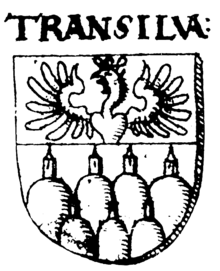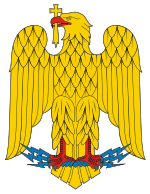- Historical coat of arms of Transylvania
-
Historical coat of arms of Transylvania 
Details Adopted 1659  Coat of arms of Transylvania, as created by Levinus Hulsius in 1596
Coat of arms of Transylvania, as created by Levinus Hulsius in 1596
The first heraldic representations of Transylvania date from the 16th century. One of the predominant early symbols of Transylvania was the coat of arms of Sibiu city. In 1596 Levinus Hulsius created a coat of arms for the imperial province of Transylvania, consisting of a shield party per fess, with a rising eagle in the upper field and seven hills with towers on top in the lower field. He published it in his work "Chronologia", issued in Nuremberg the same year. The seal from 1597 of Sigismund Bathory, prince of Transylvania, reproduced the new coat of arms with some slight changes: in the upper field the eagle was flanked by a sun and a moon and in the lower field the hills were replaced by simple towers.[1]
Transylvania's coat of arms adopted by the Diet of 1659 represents the privileged nations who were subjects of officially accepted religions in the region (Roman Catholics, Calvinists, Lutherans, and Unitarians), while Orthodox Christians (overwhelmingly Romanians; some Ruthenes present in Carpathian Ruthenia), however, were only tolerated. It depicts:
- on a blue background, a black eagle[2][3] or Turul[4][5] facing dexter, with gold bill and red tongue representing the Transylvanian medieval nobility.
- a red dividing band (originally not part of the coat of arms).
- seven red towers with black doors in two series (4+3) on a gold background representing the seven fortified cities of the Transylvanian Saxons - the display is connected with German name of Transylvania - Siebenbürgen ("Seven Fortresses").
The red dividing band was used for the first time by Prince Michael I Apafi, and its first variant was featured on gold coins he issued in 1666.
On the coat of arms used after 1765 was the new Grand Principality crown, awarded by Maria Theresa of Austria, and two women supporters representing abundance (dexter) and justice (sinister); the figures were removed in 1848, when Transylvania was reunited with the Kingdom of Hungary (see Revolutions of 1848 in the Habsburg areas). The historical coat of arms was used within the coat of arms of the Hungarian Kingdom from 1867 (after the Ausgleich and until 1949).
References
- ^ Dan Cernovodeanu, Ştiinţa şi arta heraldică în România, Bucharest, 1977, p. 130
- ^ http://books.google.com/books?id=ngABAAAAMAAJ&q=%22stema+transilvaniei%22+acvila&dq=%22stema+transilvaniei%22+acvila&hl=en&ei=CopLTqmNFM6g-wal7eSeCQ&sa=X&oi=book_result&ct=result&resnum=2&ved=0CC0Q6AEwAQ
- ^ http://books.google.com/books?id=6pVnAAAAMAAJ&q=%22coat+of+arms+of+transylvania%22+eagle&dq=%22coat+of+arms+of+transylvania%22+eagle&hl=en&ei=iatLTvTaMeXh4QTC0s3BCg&sa=X&oi=book_result&ct=result&resnum=7&ved=0CEEQ6AEwBg
- ^ Louis Craig Cornish, Transylvania, the land beyond the forest, Dorrance & company, 1947 p. 23
- ^ Michael Kosztarab, Transylvanian roots: the true life adventures of a Hungarian-American, Pocahontas Press, 1997, p. 43
This article is part of the Romanian heraldry series National 
Historical provinces Wallachia • Moldavia • Northern Dobruja • Transylvania • Oltenia • BanatCounties Alba • Arad • Argeş • Bacău • Bihor • Bistriţa Năsăud • Botoşani • Braşov • Brăila • Buzău • Caraş-Severin • Călăraşi • Cluj • Constanţa • Covasna • Dâmboviţa • Dolj • Galaţi • Giurgiu • Harghita • Hunedoara • Ialomiţa • Iaşi • Ilfov • Maramureş • Mehedinţi • Mureş • Neamţ • Olt • Prahova • Sălaj • Satu Mare • Sibiu • Suceava • Teleorman • Timiş • Tulcea • Vaslui • Vâlcea • VranceaCounty Capitals
(Municipalities, Cities, Communes)Alba-Iulia • Alexandria • Arad • Bacău • Baia Mare • Bistriţa • Botoşani • Braşov • Brăila • Bucharest • Buftea • Buzău • Călăraşi • Constanţa • Craiova • Cluj-Napoca • Deva • Drobeta-Turnu Severin • Focşani • Galaţi • Giurgiu • Iaşi • Miercurea-Ciuc • Oradea • Piatra Neamţ • Piteşti • Ploieşti • Râmnicu Vâlcea • Reşiţa • Satu Mare • Sfântu Gheorghe • Sibiu • Slatina • Slobozia • Suceava • Târgovişte • Târgu Jiu • Târgu Mureş • Timişoara • Tulcea • Vaslui • ZalăuMinistries Other institutions Categories:- Coats of arms of former countries
- History of Transylvania
Wikimedia Foundation. 2010.
